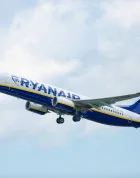Canadian affordable aviation aficionados can rest easy, as Canada Jetlines, a new ultra low-cost carrier, has now received an Air Operator Certificate from Transport Canada. This was the last step before the airline can take to the skies, and the maiden voyage is set for August 29, 2022.
The airline’s new base of operations will be the venerable (and crowded) Toronto Pearson International Airport.
Let’s dig a bit deeper into this news, as well as the potential ambitions of yet another erstwhile disruptor in the Canadian budget airline landscape.
Maiden Flight of Canada Jetlines
While Canada Jetlines had completed their necessary applications to the government to fly by July 8, the processing time has clearly taken longer than expected. As of August 18, 2022, Canada Jetlines has finally obtained its air operator certificate, allowing it to commence operations at the end of this month.
The first flight of Canada Jetlines will take place on August 29, 2022; however, the company’s press releases on their Twitter account and to the Financial Post indicate that further scheduling is still to be determined.
At present, the carrier only operates a single Airbus A320-200, which has previously been flown by Avianca and Pegasus Airlines. The lone aircraft was delivered in February of this year, following extensive refitting and refurbishment in the aviation hub of Shannon, Ireland.

The initial routes will be launched from Jetlines’s home base of Toronto Pearson, servicing the mid-sized, but not always consistently-flown, Moncton and Winnipeg markets.
The carrier’s website also proposes Niagara Falls and Prince Edward Island as destinations, which is exciting for would-be vacationers, but these aren’t yet bookable locations. As of now, there appears to be no set date for when Niagara Falls or Prince Edward Island will be loaded into the schedule.

A Familiar Business Model
When it comes to operations, the structure of Jetlines’s business is one that many of us have become accustomed to in the wake of soaring fuel prices: an ultra low-cost carrier with no frills.
Onboard dining is sure to be from a menu that is just as short as it is uncomplicated, and most definitely won’t include caviar. I’m sure that Jetlines’s flight attendants are friendly and professional, but one can hardly expect an Emirates First Class level of pampering.
The airline offers a whopping four fare options, with its top offering resembling its full-fare cousins over at WestJet and Air Canada. The lower-tier fares resemble those of other ultra budget carriers.
Either way, these myriad classes are designed to do one thing very well: extract money from customers for nice-to-have extras, such as seat selection or flexibility in rebooking. This is the industry standard for low-cost carriers, so there aren’t any surprises here.
For my money, Jetlines’s main appeal will be in its lower-tier products. If you’re going to get a basic experience, you may as well pay a basic price.
When it comes to luggage, Jetlines’s policy has the mandatory upcharges when it comes to checked luggage. You’ll pay $50 for the first bag, $75 for the second, and much more for sports equipment or other oversized items.
Passengers will be able to check up to five bags, although no prices are listed for each bag past the second.
On the other hand, the airline is much more obtuse on its policy toward carry-on baggage or personal items. Jetlines’s baggage FAQ doesn’t have any notice of whether personal baggage will be permitted or not:
Many travellers, including me, have purchased small bags for the specific purpose of not being dinged additional fees when flying with ultra low-cost carriers, so this definitely needs to be made clear prior to takeoff.
Is Canadian Aviation Reaching Market Saturation?
There’s a Sword of Damocles hanging over the head of this budding enterprise: all of Jetlines’s competition is roaring into action in a post-pandemic world.
Just in the past year, I’ve written about the launch of Lynx Air, whose CEO has a fantastic record as a successful executive in the tight-margin world of low-budget aviation.
Lynx itself joined a rapidly-filling market. The airline scrambled to get its wings off the ground before other airlines, such as Flair, could complete its moves to expand its fleet and eat up more of the budget leisure traveller segment of the market.
On top of this, many other ultra low-cost carriers make a point of keeping their most desirable routes staffed to fly as often as possible. As an Edmontonian, I often hear horror (or horrifically amusing) stories of parties gone awry – all enabled by the direct Swoop flight to Sin City.
Heck, anyone based out of the larger Canadian cities of Montreal or Toronto can even book entire vacation packages that include flights with Sunwing at a meaningful discount over their full-fare competitors.

So, what does Canada Jetlines bring to the table that’s new?
Will they be able to capture the imagination of a loyal customer base, or will they be fighting over a more niche segment of the Canadian market with more established rivals?
Will their customer service be excellent, or will passengers be “served” by a bot?
Only time can answer these questions, but for now, the underlying differentiator seems to be Jetlines’s airport strategy.
Other ultra low-cost competitors tend to be headquartered in sizeable, secondary markets, such as Calgary, which is home to both Lynx Air and Swoop. While stationed in a smaller hub, these airlines provide transport to larger cities, including ones with busy hubs, such as Vancouver, Toronto, and Montreal.

Jetlines seems to not just be refurbishing its aircraft in Ireland, but its ideas, too. The carrier’s strategy closely follows that of Ryanair: offering ultra low-cost tickets by avoiding higher-traffic airports.
The savings that come from the lower fees and levels of congestion associated with these airports can then theoretically be passed onto customers.
However, even this model doesn’t seem novel. Lynx, for example, mostly services large cities, but also goes further afield to places such as Kelowna in British Columbia and St. John’s in Newfoundland.
I wish Jetlines luck, but this certainly seems to be a difficult position to launch from, particularly with only a single aircraft in their fleet. They wouldn’t be the first airline in Canadian history to launch with lofty promises only to later be Jetsgo’d….
Conclusion
It will be interesting to watch the maiden voyage of Canada Jetlines, and I hope they will be able to proceed with a launch date of August 29. The approval of the airline’s Air Operator Certificate is certainly a step in the right direction.
Their choice to provide service to smaller locations, such as Moncton and Winnipeg, appears a bit strange on the surface, but it lines up with the company’s strategic vision of providing lower prices by servicing secondary markets.
Still, Canada Jetlines is up against quite a few competitors. In the past, the Canadian aviation industry has seen larger airlines eating up the smaller competitors, and it would be sad to see this cycle repeat yet again. May the odds be ever in the best carrier’s favour.


















They have one aircraft. So if that one is disabled in some way guess what you are not going anywhere
I wish them luck but who in their right mind would book on this airline?